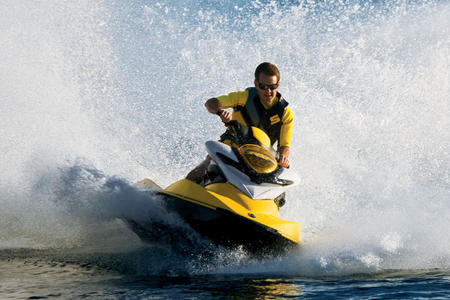2009 Sea-Doo RXP 215 Review
This two-seater still packs a punch
Sea-Doo’s RXP 215 once dominated the performance two-seater market. Its horsepower topped the charts, as did the boat’s top speed and acceleration. But though the 215hp engine may no longer rule the water in terms of sheer available horsepower in a two-passenger craft — Sea-Doo’s own 255hp RXP-X currently lays claim to that title — the RXP 215 hasn’t lost much of its performance edge.
Still Potent
The entire Sea-Doo line revolves around the same core engine, a 1494cc triple-cylinder four-stroke. Increasing that engine’s horsepower is a simple matter of how much is added on. In the case of the RXP 215, those add-ons include a supercharger, as well as an intercooler to further chill the air being force fed to the engine. The horsepower rating is listed at 215hp, probably a little high knowing Sea-Doo’s tendency to take full advantage of the marketing spin available. Still, as this craft continues to prove on the water, whatever the number it’s more than enough to keep the RXP 215 in the top ranks.
With a light five-gallon load of fuel, and my 155-pound passenger weight, the RXP peaked above the 67 mph mark in calm conditions. Conditions can vary, as can boats leaving the factory, but I would expect a legitimate 65 mph boat in most everyday conditions. Acceleration is likewise strong, pushing the boat to a 2.0-second romp from 0-30 mph.
 The RXP 215 feels agile and lightweight on the water.
The RXP 215 feels agile and lightweight on the water.No doubt, that kind of speed and acceleration is fun, but what completes the ride is the RXP’s nimble handling. The boat’s 779-pound displacement feels lightweight and agile on the water, allowing the driver to seemingly toss the boat around at will. It hooks into an aggressive corner, and that power helps rocket you out the other side with arm-wrenching efficiency. Yes, a tradeoff exists. That lightweight feel also makes the boat get bounced around a little more in rough waters. Sea-Doo’s have always had a tendency to skip along the top of the waves a little more than the competition, which often seems to bash its way through. That can make the ride feel a little too loose on occasion, but it’s a feeling that you can learn to live with. For the consumer, it will likely come down to style preference — you either like a Sea-Doo’s style of handling or you don’t.
The relaxed steering angle of Sea-Doo’s past is now several years removed. Instead, drivers now find a handlebar angle that offers an aggressive position that allows the driver better control over the agile hull below. A button on the left hand grip controls an electric trim; angle can be monitored on the info display.
Loads Of Extras
Extras are the familiar Sea-Doo trademarks. That includes the Off Power Assisted Steering (OPAS) system, which provides some directional control in a collision-avoidance situation by lowering dual, stern fins into the water, which pivot in conjunction with the direction of the handlebars. The system one-ups conventional electronic, thrust-assist alternatives by working even if the engine stalls, or the operator pulls the lanyard in panic. Don’t worry about the potential of damage to an external solution. The OPAS system has a long track record of reliability.
Dual lanyards come with the boat, one for normal operation and one that can be programmed to limit top speeds. The lanyards are also digitally encoded for security purposes; only the boat’s own unique lanyard can start the boat. Sea-Doo’s 19-function info display is easy to read, and includes both a lake temperature reading and a digital compass.
Reverse continues to be the best in the business, with an easily operated lever located on the portside of the console that allows you to manipulate throttle at the same time as reverse. No catch or detent in the lever’s throw allows you to smoothly move through the forward/neutral/reverse range with ease.
In fact, the only real drawback remains the boat’s thumb throttle. Again, it’s a preference issue, but I’ve found most riders note it’s awkward and tiring over a long ride. Sea-Doo’s own “X” model RXP offers a trigger.
Last Call
The lasting impression of the RXP 215 is that of a powerful, nimble machine that can still run with the top guns. Yes, the RXP-X is better for the pure performance freak. But let’s revisit those numbers. The 215 frequently nips at the heels of its 255hp sibling…and saves you nearly $1,500.
In my book, that makes it a favorite.
| Sea-Doo RXP 215 Specs | |
| Length | 121.0 inches |
| Beam | 48.0 inches |
| Dry Weight | 779 lbs |
| Engine | Three-cylinder EFI, Supercharged/Intercooled |
| Displacement | 1,493.8 cc |
| Bore and Stroke | 100mm x 63.4mm |
| Compression Ratio | 8.4:1 |
| Rated Horsepower | 215 |
| Fuel Capacity | 15.9 gal. |
| Combined Stowage Capacity | 10.7 gal. |
| Colors | Bright Yellow |
| Price | $11,999 |
Related Reading
2008 Sea-Doo RXP-X Review
2008 Sea-Doo RXT-X Review
Get PersonalWatercraft.com in your Inbox!
Like PersonalWatercraft.com on Facebook
Comments
Most Popular

2025 Yamaha JetBlaster PRO 2-Up Review

Remembering the Sea-Doo XP

2024 Kawasaki Jet Ski STX 160X Review

2017 Kawasaki Jet Ski Ultra 310LX Review

Whatever Happened to the Wetbike?















 Your Privacy Choices
Your Privacy Choices